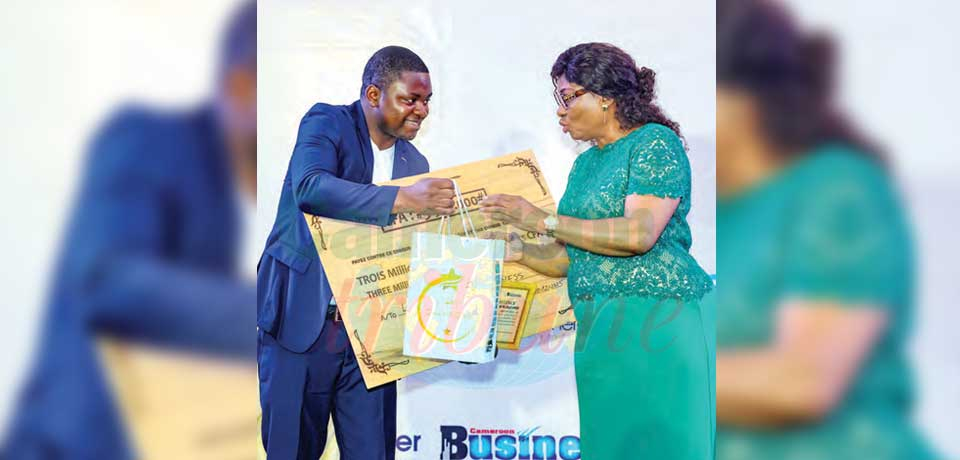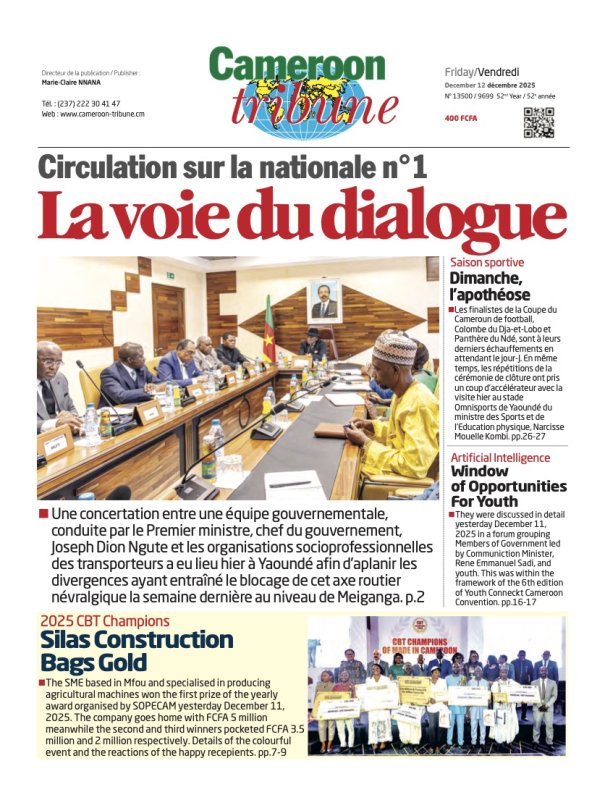Interview: “Mining Code Implementation Decree Is The Key”
- Par Kimeng Hilton
- 29 Aug 2023 17:03
- 0 Likes

Justin Landry Chekoua, Programme Manager for Mining Governance, “Forêts et Developpement Rural,” FODER, reviews the gains, challenges and sustainability prospects of the ProMESS artisanal mining project in the East and Adamawa Regions of Cameroon.
How did the “Projet Mines, Environnement, Santé et Société, ” ProMESS project come about?
The environmental association, “Forêts et Developpement Rural,” FODER has been working in natural resource governance for over 20 years. We began with the sustainable management of forests after realizing that people living adjacent logging concessions were not involved in what was happening in their backyards. Though on paper – they were the overseers of these forests! We later found out that the situation in the artisanal mining sector was even worse. That is why we did a two-phase, 8-year project to address the concerns of people living in mining communities – the “Projet Mines, Environnement, Santé et Société,” ProMESS.
What problems did you notice with artisanal mining which the project tried to address?
The problems were of different types – economic, environmental and societal. The advent of semi-mechanized artisanal mining by foreigner companies using heavy-duty equipment has posed a big environmental challenge. Before then, local people were involved in artisanal mining, using crude or basic tools with no impact on the environment. The earth-moving equipment used by semi-mechanized artisanal companies have caused great damage to the environment, especially in Betare Oya area of Loum and Djerem Division of East Region.
Mining shafts and deep pits were often left unfilled at the end of mining. In which many people have met their deaths. Locals who went digging for gold in wide open mining shafts left behind by semi-mechanized artisanal mining companies were often covered up in landslides. Animals also died by falling into the trenches which were often covered with grass.
Mining demands much water to wash the dug up laterite to pick out gold particles. Water sources became polluted and contaminated from the washing of laterite. The quantity of fish catches also reduced as a result of the use of mercury by artisanal miners to wash laterite. Moreover, soils have been degraded and are no longer arable after being dug up during mining without restoration.
There were several work-related accidents. Between 2014 and 2023, at least 200 people lost their lives in abandoned, open mining shafts in the East and Adamawa Regions. The advent of semi-mechanized artisanal mining also attracted many children into mines, greatly reducing school enrolment levels. Instead of being in school, many children turned to artisan mining to make quick money. All this, in total disregard of the law.
There were conflicts between local communities and owners of semi-mechanized artisanal gold mining concessions. The companies were often accused of grabbing large swathes of land from local people to carry out mining. Artisanal gold miners also accused semi-mechanized artisanal mining companies of driving them from “their mines” without any compensation.
Artisanal gold mining has had a negative impact on food crop production. Many people abandoned agriculture for gold mining because it yields more and quicker money. It thus became difficult for people in mining communities to eat because of food shortages. Understandably, the cost of food rose sharply.
How many of the artisanal miners operating in the East and Adamawa Regions are foreigners? Are Cameroonians from other regions also involved?
This information does not exist – neither with government nor FODER. In 2018, the number of artisanal miners in Cameroon was estimated at more than 50,000. Some 80 per cent of artisan miners in Cameroon operate in the East Region. This is old data from the Artisan Mining Support and Promotion Framework, CAPAM.
Most of the foreign artisanal miners are Central African Republic, CAR nationals. While others are from Burkina Faso and Mali. With the ongoing conflict in the North West and South West Regions of Cameroon, some displaced people have joined artisanal mining in Adamawa and East Regions. So also are Internally-displaced People from the war against Boko Haram in the Far North Region of Cameroon.
What drew the foreign miners to Cameroon?
Artisanal mining offers quick returns. Most CAR citizens involved in artisanal mining in Cameroon are refugees who fled the wars back home. The Central African Republic, it should be noted, owns richer mining reserves than Cameroon. For Burkinabe and Malian nationals, they were also involved in artisanal mining back home. They have better techniques of extracting higher quantities of gold particles from laterite than their Cameroonian counterparts.
How many children and women are involved in artisanal gold mining in the East and Adamawa Regions?
The International Labour Organisation, ILO is currently carrying out a study on children in mines in the two regions. Children in artisanal mining can be grouped into two – those working on their own and those working for their parents. The tendency is to have more children in mines during holidays. Up to 50 per cent of the total artisanal mining population is made up of children during school periods. But the number often rises to between 60 per cent and 70 per cent of the artisanal mining population during holidays.
There are fewer women in mines during planting season. But generally, there are more men than women in mines. Women carry out specific, less tedious roles like transporting dug up laterite and washing it to select gold particles. While the men do the digging in deep pits.
What is the position of Cameroonian law on artisanal mining?
Artisanal mining in Cameroon is regulated by the law – by the Mining Code. You need a mining card and a mining authorization/license/concession to operate. They are issued by the Regional Delegations of the Ministry of Mines and Technological Development, MINMIDT, upon approval by the Minister. This is the only law on artisanal mining in Cameroon.
Why then is the law not implemented?
The Mining Code was signed in 2016, but the implementation decree is still awaited. People take advantage of this vacuum to commit abuses on the ground. This is why most artisanal mining is carried out without license. They are illegal miners.
What were the challenges of ProMESS project during 8 years of implementation in two phases?
The first challenge was to get the State to regulate mining, which before then was like no-man’s land. Everything went on, with everyone involved in illegal mining. The second challenge was to get artisanal miners to operate formally by respecting the law –that is, obtain artisanal mining cards and licenses, set up mining cooperatives and adopt good practices.
The third challenge was to ensure that artisanal miners diversified their source of income by getting involved in agriculture. These are the three main areas through which the project sought to bring about change.
How was the project able to surmount these challenges?
The first thing we did was to build the capacity of staff of the Ministry of Mines and Technological Development, the Ministry of Environment, Nature Protection and Sustainable Development, and CAPAM. We trained them to monitor semi-mechanized artisanal and artisanal mining - especially the environmental aspects.
We also trained journalists on mining governance, communication and advocacy. And stakeholder communities on their rights in mining sites. For example, how they could independently monitor mining activities in their communities and report abuses and violations of the law.
We structured miners into 14 artisanal mining cooperatives in the East and Adamawa Regions. We assisted some to obtain miners’ cards and mining licenses. Today, about 200 artisanal miners own miners’ cards in the two regions. At the beginning of the project, only 10 owned such cards!
We also set out to obtain 10 artisanal mining licenses or concessions for miners’ cooperatives. Documents were compiled and submitted for four miners’ licenses, but there have been delays in the Ministry of Mines and Technological Development. This is no longer our responsibility. We did our best!
The project trained and retrained on health and safety in artisanal mines. We also offered work safety equipment to formal artisanal miners. We worked on child labour by sensitizing and organizing mining communities to send their dropout children back to school. We succeeded in sending between 3,000 and 4,000 former dropouts in mining communities back to school. We helped to create and equip four Parent Teacher Association, PTA schools with benches in mining communities where there were no schools. We also signed agreements with artisanal miners, forbidding child labour in mining sites during school periods.
Concerning activities to raise alternative income, we trained artisanal miners in improved banana and plantain farming. Today, they have cultivated at least 10 hectares of banana and plantain in Meiganga area of Adamawa Region. Thanks to the project, banana and plantain farming has been introduced in the zone. We also brought in improved cassava varieties, which are now cultivated in three villages in Meiganga.
Artisanal miners also received trained in bee farming. They have so far harvested at least 400 litres of quality honey. We trained and worked with many journalists. In all, journalists produced almost 300 articles in 8 years of ProMESS project on artisanal mining activities in the East and Adamawa Regions. We offered technical equipment to journalists to enable them carry out investigations in the field. The project offered prizes to journalists and organized the Central African Sub-regional Artisanal Mining Forum in January 2023 in Yaounde, Cameroon, which was well covered by the media.
ProMESS project has just ended after two phases lasting 8 years. What next?
We are working hard to get the project continued. Though this might take some time. We can confidently say the project achieved much in communities where we worked. Which would not have been the case if the project had not existed.
We are mobilizing funds for the next phase of the project with other partners. For example, we are currently discussing with the German Technical Cooperation, GiZ, but the new project phase will cover only one region. We are also working with the European Union to finance another phase of the project.
What are some of the major project achievements? What changes did ProMESS bring about?
ProMESS project directly impacted the lives of at least 5,000 artisanal miners in the East and Adamawa Regions. Apart from these two regions directly concerned by the project, ProMESS’ success has won admiration beyond the borders of Cameroon. For example, authorities in the Democratic Republic of Congo, DRC have invited FODER to come over and share its experience in restructuring artisanal mining. And also do a sub-regional project on artisanal mining.
They found out about our work through the many articles and reports published on the project. For example, we did a documentary on child labour in Cameroon’s mines with France 24 television. The documentary has so far been watched by at least 50,000 people on France 24’s website.
How will the sustainability of project gains be assured?
The project’s sustainability can be viewed from several angles. We offered training to government officials. Staff of the Ministry of Mines and Technological Development are for the most part young people who just left school with no field experience. Training them in monitoring mining is important for the sustainability of the project. The knowledge they acquired will continue to be useful in their activities.
Journalists continue to undertake investigative reports in mines to help change the situation. Thanks to the knowledge and competence they acquired in the course of the project. As for artisanal miners, they continue to seek our help in acquiring artisan miners’ cards and artisan mining licenses or concessions. They have understood the importance of abiding by the law.
On child labour in mines, the PTA schools we helped to create continue to function. In the first year of going operational, one of the schools had 100 pupils. Three years on, it has a whopping enrolment of over 700 pupils! This shows that community people have understood the importance of education for their children. Even if these children are allowed to work in mines during holidays.
On alternative sources of income, artisanal gold miners have taken greater interest in farming. In one village where plantain was not previously grown, the practice is taking roots. And they are making much money from it as well as from mining. Though the project has ended, the gains will not be affected. Beneficiary artisanal miners continue to put the acquired knowledge and skills to good use.
ProMESS project has just ended. What are your recommendations to overcome the problems noticed in artisanal mining?
The first recommendation is for the implementation decree of the Mining Code to be signed. This is at the political level. It will help to resolve many problems. For now, staff of the Ministry of Mines and Technological Development cannot take certain decisions for want of the implementation decree...
Cet article complet est réservé aux abonnés
Déjà abonné ? Identifiez-vous >
Accédez en illimité à Cameroon Tribune Digital à partir de 26250 FCFA
Je M'abonne1 minute suffit pour vous abonner à Cameroon Tribune Digital !
- Votre numéro spécial cameroon-tribune en version numérique
- Des encarts
- Des appels d'offres exclusives
- D'avant-première (accès 24h avant la publication)
- Des éditions consultables sur tous supports (smartphone, tablettes, PC)














Commentaires